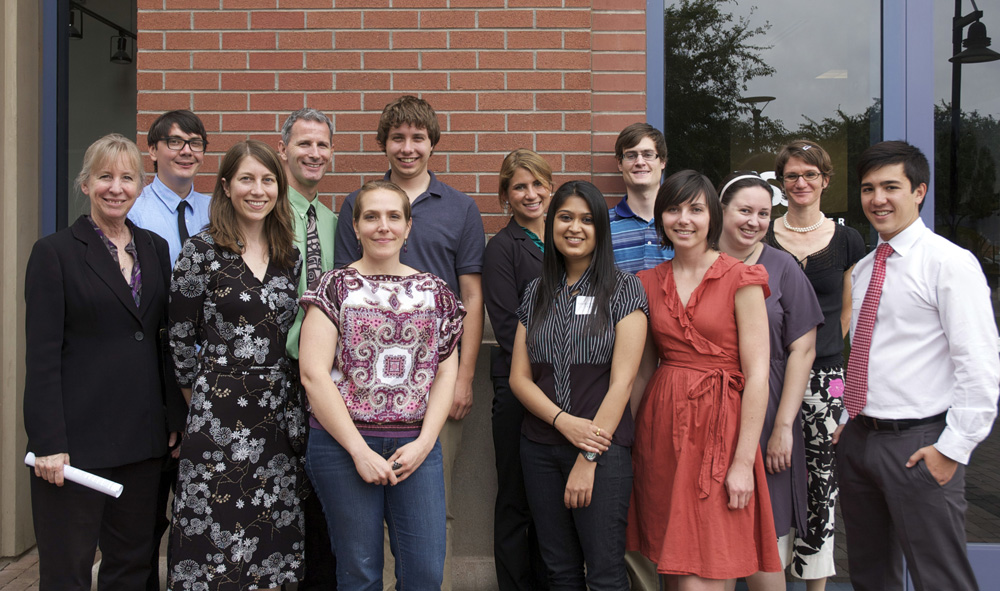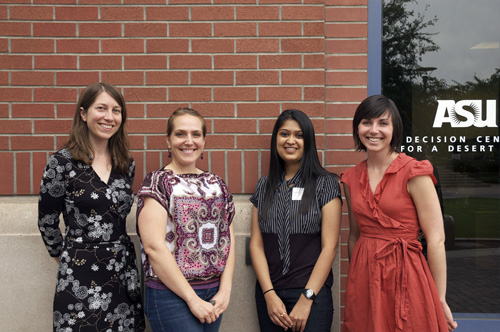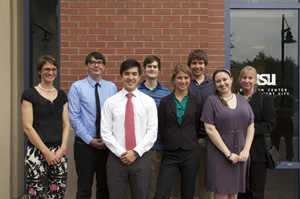
On April 25, 2012, Decision Center for a Desert City hosted their annual poster symposium. A highlight of the spring semester, graduate students enrolled in the Community of Graduate Scholars and undergraduate students participating in the Internship for Science-Practice Integration program presented the results of their DCDC research projects.
Community of Graduate Scholars (CGS)
The Community of Graduate Scholars is a year-long, one-credit course that gives graduate students the opportunity to become leaders in transdisciplinary approaches to research, policy, and community engagement.

DCDC faculty members are involved in interdisciplinary collaborations that offer rich opportunities to graduate students. Each CGS student works on a research team that includes one or more faculty members and both graduate and undergraduate students; this work provides them with the intellectual depth necessary to contribute to DCDC’s research.
CGS provides graduate students with a supportive environment where they can:
- develop a broad understanding of the research process and how it is practiced across sciences
- develop a professional and unique intellectual identity and voice
- improve scientific communication and presentation skills
- engage with researchers and community partners
- make contributions to DCDC as a boundary organization
Posters
- Envisioning Water Futures in the Greater Phoenix Area: What Do We Want The Future To Look Like? – Lauren Withycombe Keeler (CGS), Arnim Wiek, Dave White, Kelli Larson, and Kendon Jung
- Psychological Barriers to Water Conservation: The Case of Desert Landscaping – Rebecca Neel (CGS), Edward Sadalla, Susan Ledlow, Anna Berlin, Samantha Neufeld, Yexin Li, and Claire Yee
- Half Full? Buffering Central Arizona Farmers from Signals of Environmental Change – Julia C. Bausch (CGS), John P. Conners, and Hallie Eakin
- Distributed Hydrologic Modeling of Semiarid Basins in Arizona: A Platform for Climate Change Assessments – Gretchen A. Hawkins (CGS) and Enrique R. Vivoni
- A Decision Making Game to Guide Water Sustainability Related to Policy Outcomes – Geetali Dudhbhate (CGS), Erik Johnston, Ajay Vinze, Rashmi Krishnamurthy, Dweepika Desai, and Qian Hu
- Interactive Computer Simulations for Public Administration Education – Rashmi Krishnamurthy, Qian Hu, and Erik Johnston
Internship for Science-Practice Integration
The Decision Center for a Desert City undergraduate internship program bridges the world of academia to the world of water management by placing students with agencies to carry out use-inspired research projects.
The DCDC internship program integrates science and practice by expecting the students:
- to work 10 hours per week on a project that is relevant to their internship mentor and agency, learning about professional practice
- to develop an original research project within the internship , linking science and practice
- to team-up with a faculty mentor, receiving academic advice and ensuring the academic rigor of their research project
- to participate in a weekly 3-credit hour class to discuss the research-based internship, building skills in the areas of communication, meeting facilitation, and presentation delivery
Posters
State-level ADWR (general governance approaches)
How Do We Catalyze Adaptive and Innovative Practices in Public Regulatory Agencies?
- McKenzie Ragan, Internship Fellow, School of Sustainability
- Michael J. Lacey, Internship Provider, Arizona Department of Water Resources
- Dave D. White, Faculty Mentor, Decision Center for a Desert City
Inter-city comparison: Planning approach 1: scenario construction as adaptive planning approach
How Scenario Planning Will Benefit Scottsdale Water Resources’ Master Planning Process
- Ariel Pepper, Internship Fellow, School of Sustainability
- Beth Miller, Internship Provider, City of Scottsdale
- Ray Quay, Faculty Mentor, Decision Center for a Desert City
Inter-City level: Planning approach 2: collaborative management: problem perception and potential solution-options
Prevalent Perceptions of Water Use in Arizona
- Colin Russell, Internship Fellow, School of Sustainability
- Mark Holmes, Internship Provider, City of Mesa
- Erik Johnston, Faculty Mentor, School of Public Affairs
What Factors Motivated the Creation of the Colorado and Kansas Water Congresses?
- Kena Fedorschak, Internship Fellow, School of Sustainability
- Mark Holmes, Internship Provider, City of Mesa
- Erik Johnston, Faculty Mentor, School of Public Affairs
Engaging businesses as multiplier of solutions
The Relationship between Restaurants and Sustainability: Marketing the Tempe FOG Program
- Michael Nicastro, Internship Fellow, School of Sustainability
- David McNeil, Internship Provider, City of Tempe
- George Basile, Faculty Mentor, School of Sustainability
Smartscape: Using Education as a Tool for Reducing Water in Desert Landscapes
- Michael Alan Babcock, Internship Fellow, School of Sustainability
- Summer Waters and Haley Paul, Internship Provider, University of Arizona Cooperative Extension
- Kelli Larson, Faculty Mentor, School of Geographical Sciences and Urban Planning and the School of Sustainability

